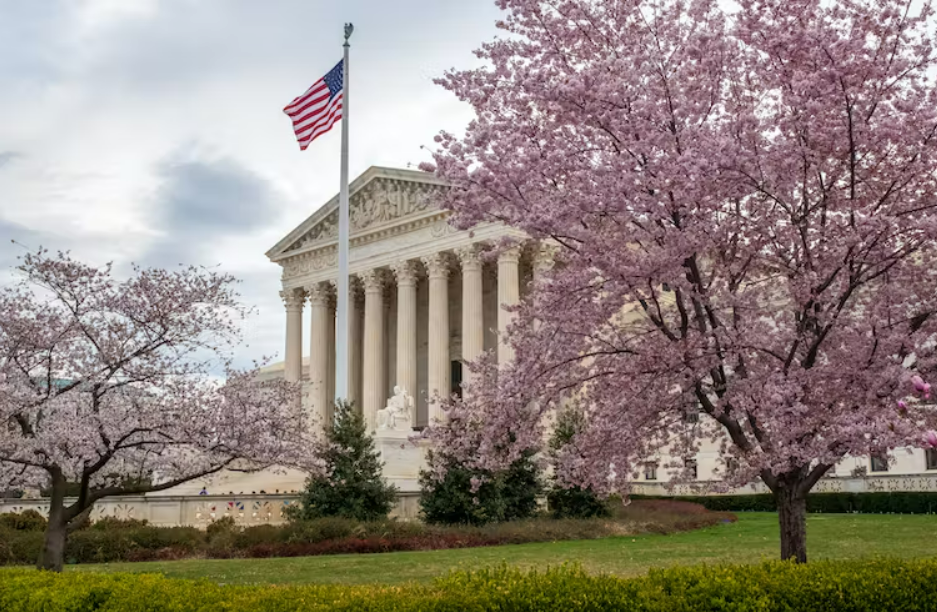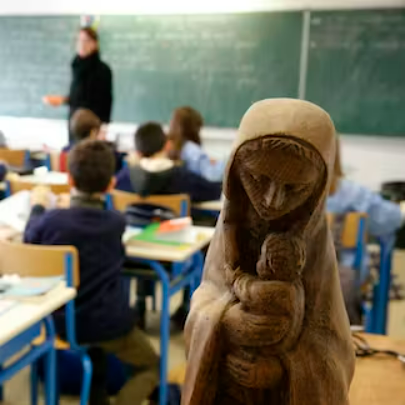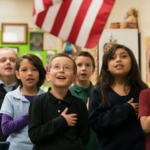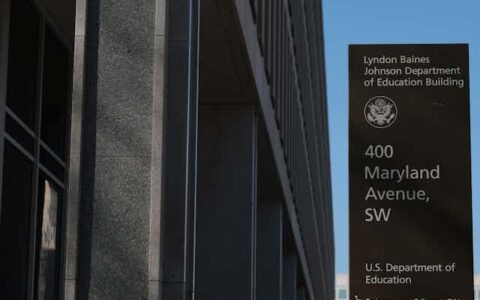Courts have wrestled with questions about public funds for students at religious schools for decades. Godong/Stone via Getty Images
Charles J. Russo, Joseph Panzer Chair in Education in the School of Education and Health Sciences and Research Professor of Law, University of Dayton
U.S. courts have long wrestled with the extent to which government funding can be used at private religious schools. And on June 5, 2023, Oklahoma’s five-person Statewide Virtual Charter School Board pushed this much-debated question into new territory by approving plans for a religious charter school – the first in the nation.
Under the proposed charter, St. Isidore of Seville Catholic Virtual School plans to open in the fall of 2024 with up to 500 K-12 students from across the state. The school would be run by the Roman Catholic Archdiocese of Oklahoma City and the Diocese of Tulsa, but, like all charter schools, would be paid for with taxpayer dollars.
School choice advocates have won key cases at the Supreme Court in recent years, opening up more ways for public dollars to support faith-based education. A charter school – privately operated, but publicly funded – would be the most dramatic of these challenges to how the separation of church and state applies to education.
“The approval of any publicly funded religious school is contrary to Oklahoma law and not in the best interest of taxpayers,” Oklahoma Attorney General Gentner Drummond said in a statement after the Monday vote, warning that the board and state will likely face legal challenges.
The key question is not whether a charter would help or harm local education, but whether explicitly religious instruction at charter schools is constitutional, given the First Amendment’s protections against government establishment of religion. Moreover, Oklahoma law requires charter schools to be nonsectarian.
Recent trend
Advocates of expanding public funding to faith-based schools have been encouraged by three recent Supreme Court cases that upheld greater aid to their students.
All three of these cases relied on a legal idea I have written about called the “child benefit test.” Essentially, according to this concept, it is constitutional under some circumstances to provide public funds to students who attend faith-based private schools or their parents – but not directly to the schools, as would happen with Oklahoma’s charter school.
The first of these decisions, 2017’s Trinity Lutheran Church of Columbia v. Comer, dealt with a private Christian preschool that was denied public grants to update its playground. School administrators sued, arguing that denying generally available funding constituted religious discrimination in violation of the First Amendment’s protections for freedom of religion. The high court agreed.
Three years later, Espinoza v. Montana Department of Revenue further opened up government aid to private religious school pupils, relying on Trinity Lutheran. A 5-4 court ruled that Montana’s tax credit program for parents sending their children to independent schools must apply even if those schools are faith-based.

Heading to a religious school or a secular one? Stephen Simpson/Stone via Getty Images
In 2022, the court extended this perspective in a case from Maine, Carson v. Makin. Maine, with its low population density, pays parents in areas lacking their own public schools to either transport their children to nearby public schools or a secular private school. The Supreme Court found that this program should apply to parents without a local public school who wish to send their child to a religious school as well.
Rethinking church and state?
By expanding the boundaries of permissible aid, these three cases have boosted proponents’ hopes for even greater public funding for faith-based schools.
Yet, it is important to keep in mind what likely prompted these changes in the first place: new faces on the Supreme Court. A majority of today’s justices tend to favor an “accommodationists” interpretation of the First Amendment, meaning they largely reject the idea that it demands a “wall of separation” between church and state, so long as the government is not privileging one faith over another.

New justices, new views. John Baggaley/Moment via Getty Images
Nevertheless, the parameters of the “child benefit test” often used to justify greater public funding has been evolving for years. The concept – one that legal scholars use to describe the Supreme Court’s arguments, not a term the court has used itself – first emerged in a 1947 dispute from New Jersey, Everson v. Board of Education. In Everson, the court upheld a state statute that allowed local school boards to transport students to faith-based schools – mostly Roman Catholic ones – reasoning that the students, not the schools themselves, were the primary beneficiaries of state aid.
In another illustrative case, 2002’s Zelman v. Simmons-Harris, the Supreme Court allowed parents whose children attended Cleveland’s public school system, which was then failing state standards, to use public vouchers to attend faith-based schools instead. A majority of justices upheld the program’s constitutionality because, again, students were the primary beneficiaries, not the religious schools themselves.
Eyes on Oklahoma
Today, in what may be the largest expansion of the child benefit test, legislators in various states are considering laws to expand how parents can participate in public education fund programs even if their children attend private religious schools, such as by broadening voucher or tax-credit programs. However, the Oklahoma proposal was the first to consider establishing a charter school with religious instruction and standards.
Charters, which trace their origins to Minnesota in 1991, are publicly funded and part of local school districts, yet free from many regulations, such as standards about curricular content and teacher qualifications. The idea of faith-based charters has attracted proponents for more than 20 years, but they have had little success until Oklahoma’s – which may never materialize, given the potential legal challenges. Americans United for Separation of Church and State has already announced it will “take all possible legal action to fight this decision and defend the separation of church and state that’s promised in both the Oklahoma and U.S. constitutions.”
Even the board that eventually approved St. Isidore, which is responsible for approving the state’s charter schools, was initially skeptical. On April 11, 2023, members unanimously voted to reject the original proposal. However, the board gave organizers 30 days to revise the proposal and try again. The second attempt in June succeeded in a 3-2 vote.
If other states authorize faith-based charters, the new schools will likely be a boon to their religious organizers by facilitating students’ ability to attend. Proponents of charters, whether traditional or faith-based, support them as part of the larger school choice movement that seeks to give parents in failing districts opportunities to move their children into better schools without paying private school tuition.
Faith-based charters are likely to raise headaches for their supporters, too. Because charters must still comply with some state standards, faith-based charters could be subject to greater government oversight about issues such as policies on LGBTQ+ students and staff – a longtime sticking point – or accepting students with disabilities. And it remains to be seen whether proponents of a Catholic charter school would be as supportive if a minority faith group proposed one.
While this legal battle is just heating up, I believe it has the potential to reshape public education as we have known it.
Editor’s note: This is an updated version of an article originally published on April 17, 2023.


















